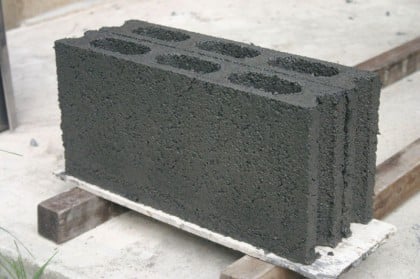Product of Hollow Concrete Blocks Mixed with Rice Husk Ash and Cassava Fermentation Waste
Main Article Content
Abstract
This research focuses on enhancing the properties of hollow concrete blocks by incorporating rice husk ash and cassava fermentation waste. The study replaces 15% of the cement with rice husk ash from a Bag Filter source and substitutes 0.5-10% of the stone dust by weight with cassava fermentation waste from Ajinomoto (Thailand) Co., Ltd. The hollow concrete blocks were formed using a cement-to-stone dust ratio of 1:10 and a water-to-binder ratio (W/B) of 0.625, with 7 x 19 x 39 cm dimensions. The test results indicate that the density of the hollow concrete blocks decreases with the addition of rice husk ash compared to control hollow concrete blocks. However, when a small amount of cassava fermentation waste is added, the weight and density of the hollow concrete blocks increase. Additionally, the moisture content of the rice husk ash mixed blocks is lower than that of the control hollow concrete blocks. Still, it increases proportionally with the inclusion of cassava fermentation waste. Combining rice husk ash and cassava fermentation waste leads to higher water absorption values in the hollow concrete blocks. Moreover, the compressive strength of the rice husk ash mixed hollow concrete blocks is greater than that of the control hollow concrete blocks. However, the addition of cassava fermentation waste reduces compressive strength.
Article Details

This work is licensed under a Creative Commons Attribution-NonCommercial-NoDerivatives 4.0 International License.
References
iEnergy GURU. (2015). Concrete masonry unit. Available online: https://ienergyguru.com/ 2015/09/concrete-masonry-unit/. (8 November 2020).
Lertwattanaruk, P.; Suntijitto, A. Properties of Natural fiber cement materials containing coconut coir and oil palm fibers for residential building applications. Construction and Building Materials 2015, 94, pp. 664-669.
CarbonCure. (2020). Innovative CO₂ Technologies. Available online: https://www.carboncure.com/technologies/. (12 November 2020).
Weeranukul, P.; Suweero, K. Development of cement boards from coconut shell ash for energy and environment conservation. Engineering and Applied Science Research 2016, 43, pp. 173-175. (in Thai)
Jindaprasert, P.; Jaturapitakkul, C. Cement pozzolan and concrete. 7th ed; ACI Partners with Thailand Concrete Association, Bangkok, 2013. (in Thai)
Hollow load-bearing concrete masonry units. Thai Industrial Standards Institute, TIS. 57-2017, Ministry of Industry, Bangkok, 2017. (In Thai)
Kinkachon, T.; Kunlawong, S.; Pattum, J.; Chaikhan, S.; Thongdamrongtham, S.; Chareerat, T. Effect of rice husk ash used as pozzolan material on properties of lightweight bricks. Journal of Science and Science Education (JSSE) 2022, 5(2), pp. 182-190.
Suwanmaneechot, P.; Chalee, W. Time to Initial Corrosion of Steel Reinforcement in Concrete Containing Rice Husk-Bark Ash under Marine Environment, Proceedings of 19th National Convention on Civil Engineering, Khonkaen, Thailand, 14-16 May 2014: pp. 830-836. (in Thai)
Ditkunchaimongkol, N. The study of efficiency and cost of cassava pulp hydrolysis by acid and enzymes. Report of academic conferences and presentations of research results national and international national group science 2015, 1(6), pp. 249-259.
Duangsrisen, W.; Treeamnuk, T.; Sukthang, N.; Arjharn, W. A Study of Drying Cassava Pulp Using a Rotary Screen Dryer. Thai Society of Agricultural Engineering Journal 2012, 19(1), pp. 7-13. (in Thai)
Boontositrakul, K.; Suweero, K.; Weeranukul, P. Using Cassava Pit Waste as Light Weight Aggregate for Hollow Load Bearing Concrete Masonry Mixed with Rice Husk Ash Product. Journal of Engineering, RMUTT 2020, 18(1), pp. 13-22. (in Thai)
Standard Specification for Portland Cement. Annual Book of ASTM Standards, ASTM C150, 2015, Vol. 04.02.
Standard Specification for Woven Wire Test Sieve Cloth and Test Sieves. Annual Book of ASTM Standards, ASTM E11, 2022, Vol. 14.02.
Standard Test Methods for Sampling and Testing Concrete Masonry Units and Related Units. Annual Book of ASTM Standards, ASTM C140, 2005, Vol. 04.02.
Standard Test Method for Linear Drying Shrinkage of Concrete Masonry Units. Annual Book of ASTM Standards, ASTM C426, 2017, Vol. 04.02.
Tonnayopas, D. Minerals and rocks, 2nd ed; Faculty of Engineering, Prince of Songkhla University, Songkhla, 2010. (in Thai)
Mehta, P.K. and Monteiro, P.J.M. Concrete Microstructure, Properties and Materials. 3rd ed; McGraw-Hill, 2006.
Jaturapitakkul, C.; Tangchirapat, W. Utilization of ash and industrial waste as material in concrete work, 2nd ed; Department of Civil Engineering, Faculty of Engineering, King Mongkut's University of Technology Thonburi, Bangkok, 2013. (in Thai)
Standard Specification for Non-Load Bearing Concrete Masonry Units. Annual Book of ASTM Standards, ASTM C129, 2004, Vol. 04.02.
Setthabut. C. Cement and applications, Thai Cement Industry Co., Ltd., Bangkok, 2009. (In Thai)
Neville, A. M. Properties of Concrete. London: Pearson Education PLC, 2011.
Akogu, A. E. Effects of sugar on physical properties of ordinary Portland cement paste and concrete. AU J.T. 2011, 14(3), pp. 225-228.
Khan, B.; Baradan, B. The effect of sugar on setting-time of various types of cements. Science Vision 2002, 8(1), pp. 71-78.
Suman, R. Effect of Sugar on Setting-Time and Compressive Strength of Ordinary Portland Cement Paste, Proceedings of 3rd World Conference on Applied Sciences. Engineering & Technology, Kathmandu, Nepal, 27-29 September 2014: 127-129.
Suryawanshi, Y. R.; Bhat, P. N.; Shinde, R. R.; Pawar, S.; Mote, N. Experimental Study on Effect of Sugar powder on Strength of cement. International Journal of Research in Engineering and Technology 2014, ISSN (E): 2321-8843; ISSN (P): 2347, 4599, pp. 249-252.
Hollow non-load-bearing concrete masonry units. Thai Industrial Standards Institute, TIS. 58-2017, Ministry of Industry, Bangkok, 2017. (In Thai)


